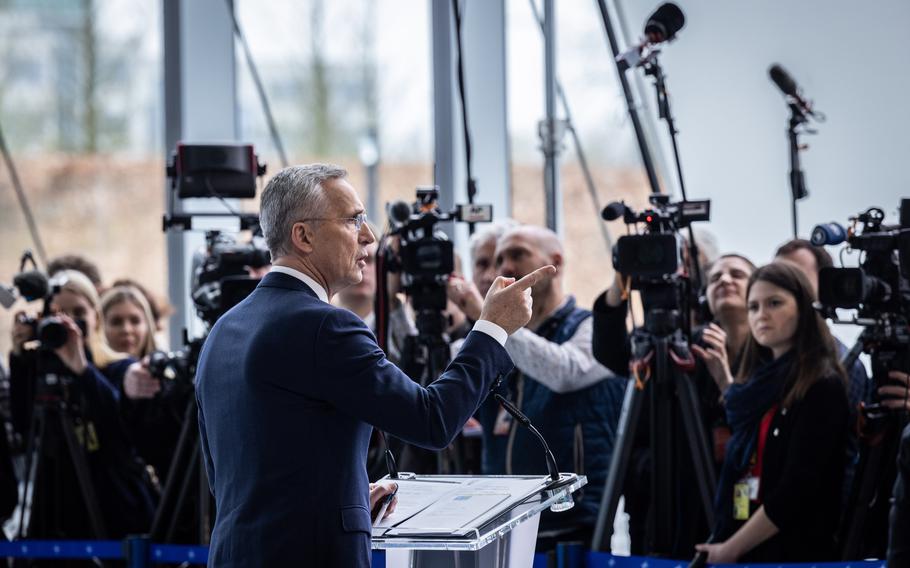
NATO Secretary-General Jens Stoltenberg speaks to reporters April 3, 2024, before the start of two days of meetings of NATO foreign ministers at the alliance's headquarters in Brussels. (NATO)
STUTTGART, Germany — Secretary of State Antony Blinken and other leaders this week will review a proposal to make NATO the planning hub for arming Ukraine as the alliance looks for ways to shake up an effort that’s been spearheaded by the United States at Ramstein Air Base for the past two years.
The alliance on Wednesday also discussed plans for a new $100 billion fund over five years to help bankroll Western support for Ukraine.
The ideas are being floated amid growing uncertainty over Washington’s ability to resolve political disputes that have put in limbo future U.S. funding for Ukraine’s war effort. The possible return of Donald Trump to the White House in 2025 also could factor into the talks, given the former president’s mixed messages on financial support for Ukraine.
NATO Secretary-General Jens Stoltenberg, speaking at the start of a foreign ministers meeting Wednesday at his headquarters in Brussels, said the time has come to shift the dynamics of allied support.
“Ministers will discuss how NATO could assume more responsibility for coordinating military equipment and training for Ukraine, anchoring this within a robust NATO framework,” Stoltenberg said.
While Stoltenberg declined to detail the separate funding plan being reviewed, Latvian Foreign Minister Krisjanis Karins, speaking on the sidelines Wednesday, confirmed that Stoltenberg’s proposal amounted to a $100 billion fund of allied contributions.
“This is the direction in which we need to think — how to pool our resources to be more effective in assisting Ukraine,” said Karins, as quoted by European Pravda.
While a final decision wasn’t expected this week, the proposals would help ensure a more reliable and predictable security assistance system for Ukraine over the long haul, Stoltenberg said.
The discussions in Brussels come as Russia ramps up the scale of its attacks on Ukraine. At the same time, weapons delivery from the West has dwindled.
Thus far, the U.S. has been the center of gravity for coordinating efforts to arm Ukraine’s military.
The so-called Ramstein Group, led by Defense Secretary Lloyd Austin, has been the face of that effort and involves more than 50 countries that meets periodically at the U.S. Air Force hub in Germany.
Meanwhile, a subordinate group at U.S. Army Europe and Africa headquarters in Wiesbaden serves as ground zero for putting support plans into action.
Stoltenberg declined to say if a new NATO effort would spell the end of the U.S.-led Ramstein Group.
But he did say uncertain funding support in Washington, where Congress has failed to reach an agreement on support for Ukraine, was hurting the war effort, forcing Ukraine to ration artillery shells.
“Any delay (in Washington) has real consequences on the battlefield,” Stoltenberg said.
While Stoltenberg didn’t connect the proposal to make NATO the focal point for arming Ukraine to dysfunction in Washington, he added that more alliance involvement would send a message of resolve to Moscow.
“Doing more under NATO would make our efforts more efficient and more effective,” he said. “Moscow needs to understand that they cannot achieve their goals on the battlefield and they cannot wait us out.”
The aim is to set the stage for a peace agreement, Stoltenberg said, adding a stronger NATO role “is the way to end this war.”
Stoltenberg said the goal is to have a final agreement on a larger NATO role ready in time for the alliance’s July summit in Washington, where heads of state will mark NATO’s 75th anniversary.